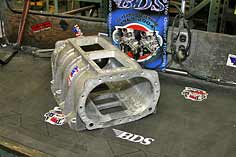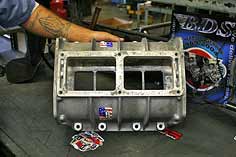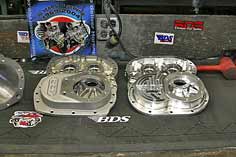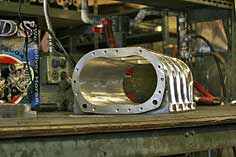
The cornerstone of a good supercharger is the case. This is an example of a clean core before machining and polishing.

Another thing that happens before assembly is that the intake and outlet sides are opened up and mating surfaces machined flat.

The next components in line are the bearing end plates and covers. BDS manufactures bearing plates in cast for a nostalgia look or billet for a more modern appearance.

The interior of the case is also machined to specification. The case is now ready for the first pre-assembly.
|
 here are two good ways to make more horsepower with any given engine. One way is to increase the volumetric efficiency of said engine and spin the heck out of it. This is a fine way to go about things, but usually involves a pile of money for hi-zoot rods, pistons, and heads along with ultra meticulous machine work and assembly to make sure it doesn't kick all those expensive parts out of the side of that equally expensive block or oil pan. This is a great path to take for a naturally aspirated, or atmospheric engine. The reason you have to spend a pile of money to keep an engine like this together is that the loads placed upon connecting rods, crankshafts, and the like are increased along with engine rpm. Tensile loads are especially tough on connecting rods and rod bolts. here are two good ways to make more horsepower with any given engine. One way is to increase the volumetric efficiency of said engine and spin the heck out of it. This is a fine way to go about things, but usually involves a pile of money for hi-zoot rods, pistons, and heads along with ultra meticulous machine work and assembly to make sure it doesn't kick all those expensive parts out of the side of that equally expensive block or oil pan. This is a great path to take for a naturally aspirated, or atmospheric engine. The reason you have to spend a pile of money to keep an engine like this together is that the loads placed upon connecting rods, crankshafts, and the like are increased along with engine rpm. Tensile loads are especially tough on connecting rods and rod bolts.
The other way to get more power out of an engine is to use forced induction to cram more air and fuel into the cylinders via the miracle of supercharging. For this you need a supercharger. The supercharger itself is in theory a relatively simple device. The supercharger takes power from the engine and uses it to force air back into the combustion chambers. The faster the engine spins, the more air gets crammed in, which makes more power, which makes the engine spin faster. So it goes.
Ever since early hot rodders took a cue from World War Two fighter planes and adopted supercharging as a proven way to make more power from less engine, the supercharger has earned its place in the drag racing pantheon of power. The roots-type blower became the standard of forced induction over Potvin or centrifugal style superchargers, thanks to used ones being readily available on GMC diesel trucks.
The way a roots-type supercharger works is: Two sets of rotating lobes spin and force air and fuel down into the engine. The lobes spin inside a housing and are connected to a set of beefy bearings at either end of the housing. A pulley and belt are connected to a set of gears inside the front bearing plate. The supercharger, therefore, spins in direct proportion to engine rpm, with boost controlled by the ratio of the pulley attached to the drive gear. A big wheel turns the small wheel faster type of deal.
|
